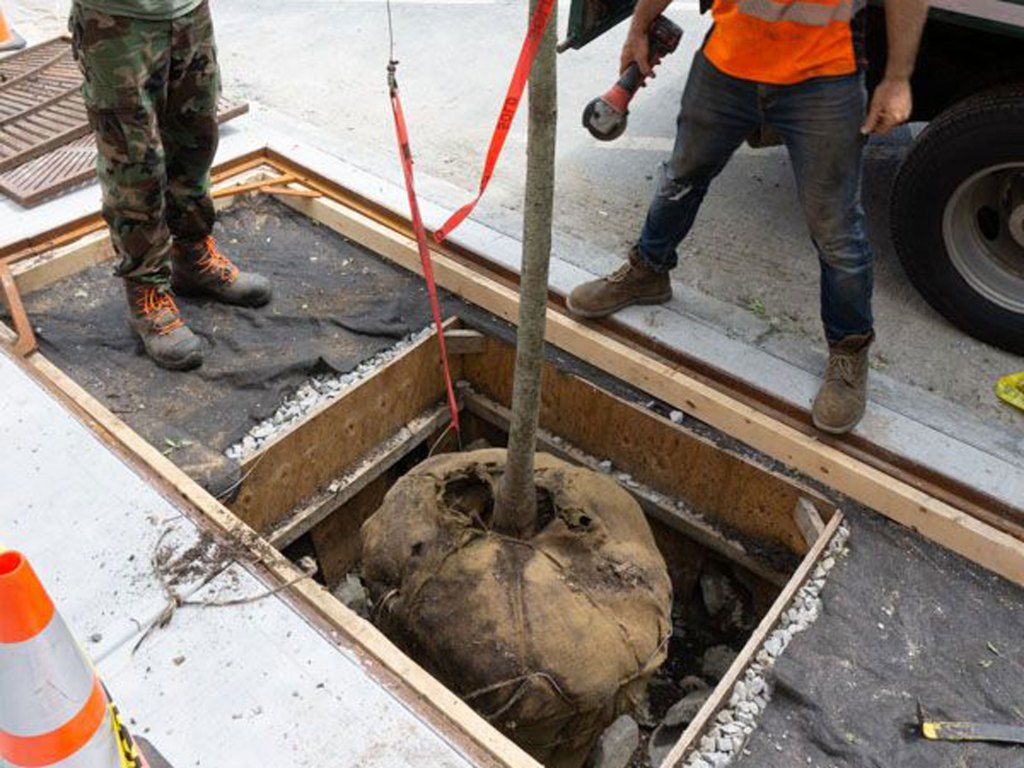This story by Jenny Blair was first published by the Montpelier Bridge on June 11.
Montpelier’s street trees often live short lives. Roots hit impenetrable compacted soils once they outgrow their planted space, often a meager 4-foot-by-4-foot square. But now, new trees taking root under downtown sidewalks should grow tall and survive to old age, thanks to a new planting method that lets them thrive in tough urban environments.
This month, the Montpelier Parks Department plans to plant two saplings on Main Street in front of Walgreens and the American Legion. Workers will prepare beds under the sidewalk using the Stockholm tree pit method, which balances the need for structural support with the trees’ needs for airy, spacious, and nutrient-rich soils.
“What we’re trying to do is basically grow a goldfish inside a shot glass,” said Parks and Trees Director Alec Ellsworth of the city’s longtime approach to tree planting.
“We were replacing trees every five to seven years,” added John Snell, chair of the Tree Board.
Enter Structural Soil
Several years ago Montpelier tree officials decided to try an innovative approach. Developed in Stockholm, Sweden, the method involves digging out a generous pit, or tree well, along 500 square feet of sidewalk, then filling it with 3- to 5-inch-diameter stones that can support compression from above.
Spaces between the stones are then filled with a mix of compost and biochar, a carbon-rich, charcoal-like substance, allowing space for roots to grow and find nutrients and air.
On top of that, a thinner layer of small stones will provide what Ellsworth explains is a natural air barrier, one that prevents roots spreading up into overlying pavement while still letting air into the pit.
Called structural soil, the pit materials bear the weight of sidewalks while giving roots space to grow and plenty of air, water, and nutrients.
Nearby, small circular grates also direct water toward the root zone rather than into storm drains, reducing rainfall runoff. (The tree wells will not prevent extreme flooding, however.)
Four young trees were planted downtown in 2021 using the Stockholm method, including an American elm in front of Mad Taco and another in front of Yankee Wine and Spirits.
The new trees — which also include a Freeman maple and two honey locusts — are thriving. Last summer, the one near Mad Taco grew by as much as 47 inches, Ellsworth estimated.
Snell said this year’s new trees will likely be a Princeton elm and a white oak.
Costs and Benefits
Each tree costs about $10,000, according to Ellsworth. Of that, approximately $7,000 pays for the cast-iron grate and cylindrical tree guard — the prices for which have approximately quadrupled since 2019, Snell and Ellsworth estimated.
But what the city is paying for amounts to much more than a leafier, more aesthetically pleasing streetscape. Trees are crucial tools for climate adaptation, beginning with their ability to improve stormwater management. Large trees also cool cities thanks to shade and the release of water vapor during photosynthesis, which in turn can reduce air conditioning costs in addition to creating more pleasant outdoor conditions.
Using a thermal imaging gun on a hot day, Ellsworth said, “the pavement might be 110 degrees. The air might be 85 degrees. And then you point at a bench in the shade [and it] might be 72 degrees.”
Urban trees also improve air quality by filtering out fine particulate matter, such as the Canadian wildfire smoke that fouled Vermont last summer. The strongest effects on air quality and temperature occur within 100 meters of the tree, according to the Nature Conservancy’s Planting Healthy Air report.
Snell also points out the economic benefits.
“There’s a direct connection in studies between having greenery in downtowns and how much money people spend in stores,” Snell said.
Research by the U.S. Forest Service has found that shoppers are willing to spend more time and pay more for products and services in business districts lined with trees. That includes paying more to park in the shade.
A Leafier Future
City officials aim to plant many more street trees with the Stockholm method, not only because the traditional method often dooms young trees, but also because many of Montpelier’s older street trees are expected to die as well.
As the emerald ash borer beetle advances, Ellsworth said, the city’s large downtown ash trees, like the one in front of Bethany Church, will succumb.
“We’re treating them to keep them alive as long as we can, but we know that they’re not going to survive,” he said.
East State Street is among the sites being eyed for a future planting project, according to Snell.
“We’d love to have that whole row of trees, which is right along the first block, end up being one long bed underground,” he said.
Funding streams for the plantings have mostly come from tree organizations, but demonstrating success might open up new sources of support, Ellsworth said.
“There’s way more funding in stormwater, downtown improvement, and that kind of thing,” he said. “If we can tap into different funding streams because we’re providing multiple benefits, then it will really help us pull this off in a more comprehensive way.”
Read the story on VTDigger here: Montpelier grows trees in stones.

